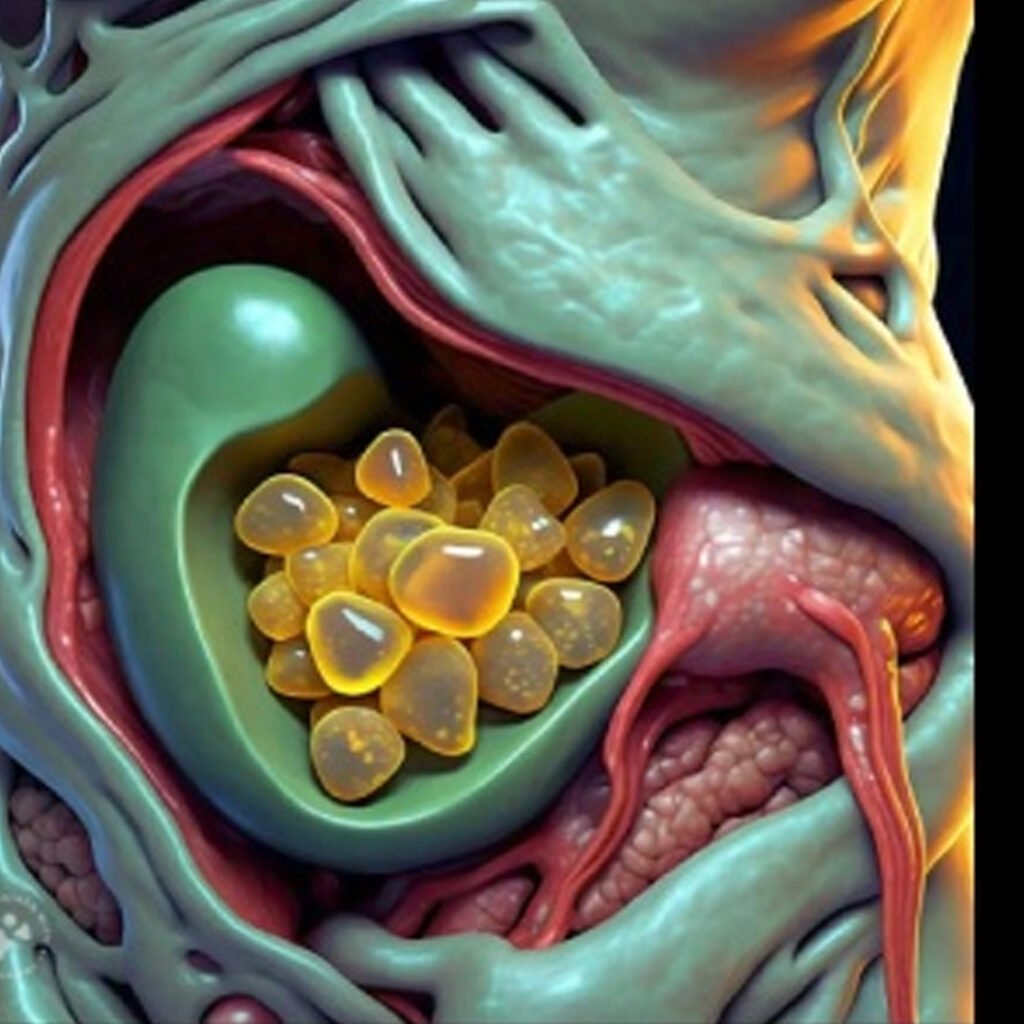Gallstones
Introduction
Gallstones are solid, stone-like deposits that develop in the gallbladder, a small organ located under the liver that stores and releases bile. They form when there is an imbalance in bile components, such as cholesterol, bile salts, or bilirubin, causing crystallization. Gallstones can range in size from tiny grains to large stones and may remain asymptomatic for years or cause severe pain and digestive issues when they block bile flow, leading to complications like inflammation, infection, or jaundice.

Types of Gallstones
Cholesterol Gallstones
These are the most common type, formed primarily from hardened cholesterol in bile. They can develop slowly and may remain asymptomatic for a long time.
Pigment Gallstones
Dark-colored stones that form due to excess bilirubin, often linked to liver disease, infections, or certain blood disorders.
Mixed Gallstones
These stones are composed of a combination of cholesterol, calcium salts, and bilirubin, representing features of both cholesterol and pigment stones.
Rare or Other Types
Uncommon gallstones caused by genetic factors, bile duct infections, or metabolic disorders, and may require special medical attention.
Causes of Gallstones:
- High cholesterol levels in bile can crystallize, forming gallstones over time.
- Increased bilirubin from liver disease or blood disorders can lead to pigment stone formation.
- Being overweight increases cholesterol secretion in bile, raising gallstone risk.
- Sudden weight loss causes bile imbalance, promoting gallstone development.
- Diets rich in fat and low in fiber contribute to cholesterol gallstone formation.
- Estrogen increases cholesterol in bile, making gallstones more likely during pregnancy.
- Genetic predisposition can make some individuals more susceptible to gallstone formation.
- Insulin resistance and metabolic imbalances in diabetes increase gallstone risk.
- Impaired bile production and processing due to liver disease can trigger gallstone formation.
- Drugs like estrogen therapy, cholesterol-lowering drugs, or ceftriaxone can increase gallstone risk.
- Older adults are at higher risk due to changes in bile composition and gallbladder function.
- Poor gallbladder emptying causes bile stasis, which promotes stone formation.
Clinical features of Gallstones:
Right Upper Abdominal Pain
Gallstones often cause sharp or cramping pain in the upper right abdomen, especially after fatty meals.
Nausea and Vomiting
Gallstones can irritate the digestive system, leading to frequent nausea and occasional vomiting episodes.
Indigestion and Bloating
Patients may experience discomfort, bloating, and indigestion after eating heavy or oily foods.
Jaundice
If a gallstone blocks the bile duct, yellowing of the skin and eyes (jaundice) can occur.
Fever and Chills
Infection caused by trapped gallstones may lead to fever, chills, and general weakness.
Symptoms associated with Gallstones:
- Abdominal pain occurs suddenly and can last from minutes to several hours.
- Nausea and vomiting often accompany gallstone attacks after heavy or fatty meals.
- Bloating and discomfort are common after eating oily or greasy foods.
- Indigestion frequently occurs, making it difficult to digest heavy or spicy meals.
- Back pain may radiate between the shoulder blades due to gallstone blockage.
- Jaundice develops when gallstones obstruct the bile duct, causing yellowing of the skin.
- Loss of appetite is common because of persistent discomfort and digestive issues.
- Fever and chills indicate a possible gallbladder infection requiring immediate medical attention.
Investigations in Gallstones:
- Ultrasound is the first-line imaging test for diagnosing gallstones. It detects the presence, size, and number of stones, evaluates gallbladder wall thickness, and identifies bile duct dilation. It is non-invasive, safe, and highly accurate in confirming gallstone-related complications like cholecystitis or biliary obstruction.
LFTs help assess liver health and detect bile flow obstruction caused by gallstones. Elevated bilirubin, alkaline phosphatase, and liver enzymes indicate gallstone-induced blockage or inflammation. These tests are often performed alongside imaging to evaluate the extent of liver and biliary system involvement.
EUS combines endoscopy and ultrasound for highly detailed images of the bile ducts, pancreas, and gallbladder. It is useful for detecting small gallstones and sludge not visible on standard ultrasound. This procedure is minimally invasive and particularly beneficial for complex cases involving bile duct stones.
MRCP uses MRI technology to visualize the biliary and pancreatic ducts in detail. It is a non-invasive test that helps identify gallstones in the bile ducts, strictures, and other abnormalities. MRCP is particularly useful when ultrasound results are inconclusive or when bile duct stones are suspected.
ERCP is both a diagnostic and therapeutic tool. It visualizes the bile ducts using contrast dye and X-ray, detects gallstones, and allows their removal if present. It is mainly used when bile duct obstruction or infection is suspected, but it carries some risks, including pancreatitis.
A CT scan provides detailed cross-sectional images of the abdomen and detects gallstones, gallbladder inflammation, or complications like perforation or abscess. While less sensitive than ultrasound for gallstones, it is useful in identifying other abdominal conditions that may mimic gallstone symptoms.
A HIDA scan evaluates gallbladder function and bile flow. It involves injecting a radioactive tracer and taking images to track bile movement. It is particularly helpful in diagnosing acute cholecystitis, where gallstones block bile flow, and can assess gallbladder ejection fraction in chronic cases.
A CBC helps detect signs of infection or inflammation caused by gallstones. Elevated white blood cell counts suggest acute cholecystitis or gallbladder infection. This test, combined with imaging and liver function tests, provides valuable insights into complications associated with gallstones.
These enzymes are tested when gallstones are suspected to cause pancreatitis. Elevated levels indicate gallstone-induced blockage of the pancreatic duct, leading to inflammation. Measuring these enzymes is crucial for detecting life-threatening complications and guiding appropriate treatment strategies.
PTC involves injecting contrast dye directly into the bile ducts through the liver and capturing X-ray images. It is primarily used when ERCP is not possible or fails. This test helps identify gallstones, strictures, and blockages in the bile ducts and assists in planning treatment.
